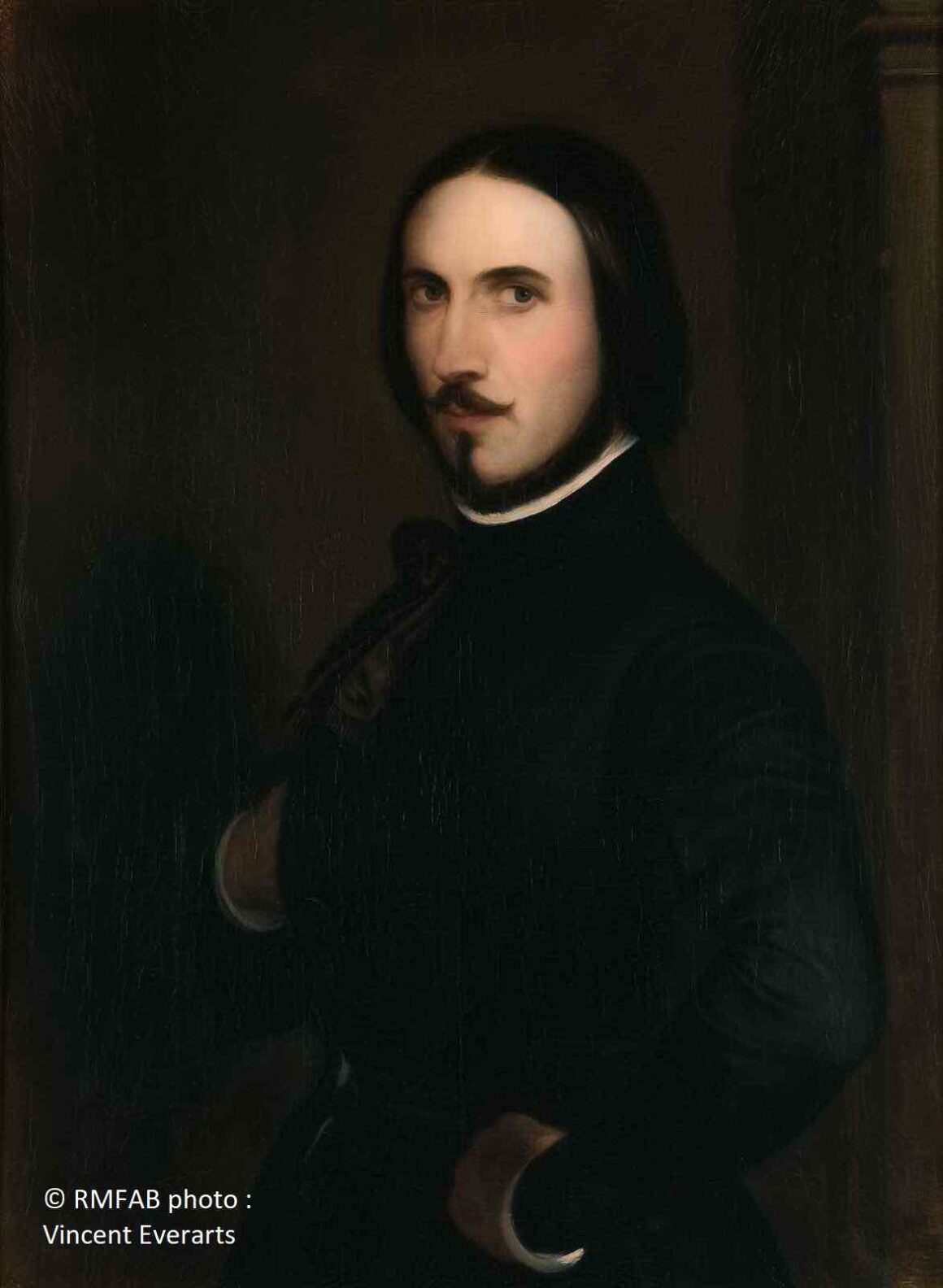We are in Brussels on a sunny day. What do we see? On the Place du Luxembourg, you’ll see a cluster of houses around a statue. What do these houses look like? They’re built in the neo-classical style, an architectural style that was very popular during the 19th century. What else is there? A few trees, a small train station that seems to be lost in front of a huge modern building made of steel and glass. This is the European Parliament and its surface perfectly reflects the day’s blue sky. It’s like a Magritte painting. It seems like the architect tried to cover his project with white clouds on a bright blue canvas. Why do I talk about this, you may ask? Well, a bit further, under the European Parliament, you’ll find a small road. A few meters further and protected by a high grey wall, you’ll find the Wiertz Museum.
The Wiertz Museum is located in a classic Brussels house. You could probably find it anywhere in the city. As you may have guessed, this house was also built in the neo-classical style at the end of the 19th century. It features a courtyard, stairs, two floors, walls covered in white paint, high ceilings and doubled doors. Next to it, you’ll find a garden, The Citizen Garden, where you can enjoy free classical concerts during the spring and summer days. Across the street is the Leopold Park. The contrast between this pristine white color and the strong green of the trees is very intense. It’s almost like this particular building was a sanctuary. I couldn’t help but wonder, who would we praise in that temple? Antoine Wiertz.


The composition of the museum is divided into 3 rooms: the entrance, the small gallery and the Atelier.
Let starts with the Atelier. It’s a huge room. The light is coming in directly through the roof made of steel and glass. It is the perfect feature that any artist needs to create his art in the best conditions. Just like the name of this room says , Antoine Wiertz created within those walls. The room is enormous. It was built to hold his work as an art collection. The painter was constantly in search of space to create his huge paintings. At the end of his life, Wiertz wanted to open the place as a museum. The room holds large-scale paintings such as The Fall of the Rebel Angels, (11.53 m by 7.93 m) and The Greeks and the Trojans fighting over the Body of Patroclus, (3.95 m by 7.03 m). It’s no surprise to see students coming there to draw, taking notes or getting inspired by the artist. There is certainly a singular vibe expressed in these paintings. Among the big canvas, you’ll see smaller statues. Delicate creatures made in white marble. This experience is all about contrast. And so, was Antoine Wiertz.



The smaller part features three salons with a collection of drawings from the artist.
The arrangement of the works remains exactly the same as Antoine knew it in his own lifetime. You’ll feel like time has stood still in this sanctuary dedicated to the wondrous things created by a singular individual. There is a peaceful atmosphere in the galleries made for contemplation, meditation, and reveries. I like to come alone to read my book.
We consider Antoine Wiertz belonging to the Romantic period in art history. What is the romantic movement, you may ask?
Romanticism celebrated the thinker as an individual. The painter would use his or her own imagination to suggest a scene and to leave the interpretation to the eye of the beholder. This movement allows the protagonist much more emotion, sometimes reflecting the sadness or the disturbance of their time. There is a certain questioning, and the painting is no longer there only to educate the visitor. This style quickly spread throughout Europe and the United States at the end of the 18th century and well into the 19th, to challenge the rational ideals held during the Enlightenment. Painters, writers and poets started to embrace subjectivity, began to explore various emotional and psychological states as well as moods.



Eugène Delacroix is one of the most famous French artists of this period with his masterpiece Liberty Leading the People. At that time, countries organised salons. The salon was a gallery where the artist could submit his (most artists at the time were men) work to a panel of judges. They would give critiques, categorise it and give prices. The press was also welcome, and the critic could be very harsh on the newcomers. The grand prize of the Grand Concours was Le Prix de Rome, meaning an educational trip to Rome in order to follow in the steps of the Italian Old Masters from the Renaissance and Baroque periods.
At number 62 rue Vautier in Brussels, you’ll find a museum dedicated to the glory of one artist.
Antoine Wiertz was born in Dinant on 22 February 1806. He came from a modest background. His father was a tailor and a supervisor at the glassworks. His mother was a day labourer. He took a vow of poverty throughout his life. A family member introduced him to the work of Rubens in Antwerp, the great baroque artist. During the following years, he discovered Raphael and Michelangelo, who left a great impression on the young man still wondering what to do with his life. In 1820, Wiertz entered the Antwerp Art Academy.
In 1828, he took part in the Grand Concours, also known as the Concours de Rome. He didn’t win, and went to Paris afterwards. The Belgian student had the opportunity to visit the museums and to study the Great Masters. Full of hope, the young artist again submitted work for the Grand Concours, and this time he landed the highly prestigious Prix de Rome (1832). He stayed in Rome between 1834 and 1837. During that period, he painted The Greeks and the Trojans fighting over the Body of Patroclus on a canvas he chose 3.95m by 7.03m, whose subject he borrowed from the 17th canto of Homer’s Iliad. Wiertz will become famous for his large-scale paintings—you might even call it his trademark. He often chose to paint on a large size canvas throughout his life.


In 1839, at the Paris Salon, Antoine decided to present his Patroclus. He didn’t receive favourable reviews and even provoked sarcasm among the critics. He felt deeply wounded and humiliated. Later on in the same year, the Brussels Salon awarded him with a medal.
Antoine Wiertz was more than a painter. He handled his pen with the same fire s his brush. He wrote a multitude of articles, brochures and pamphlets. He was a collaborator for the Revues de Salon. The artist’s written works also included Eloge de Rubens (“Elegy of Rubens”), a treatise, which won him a prize in Antwerp in 1840; and Ecole flamande de peinture (“Flemish School of Painting”), a treatise, for which he was awarded a prize by the Belgian Royal Academy in 1863. Rubens with the Flemish Masters remained a constant inspiration for him. You can clearly see it looking at the pieces in the museum.
Why do we describe Wiertz as a genius? He combined a new painting technique mixing the speed of execution, the dullness of paintings in fresco with the smoothness of oil. His style was not totally defined, moving between a classical academicism and romantic flights redolent of baroque. He was ahead of his time; you can detect some links between his works and the later Impressionist and Expressionist movements. We can’t quite see the face of the protagonist. We don’t quite understand directly the subject of the painting.
I particularly liked the two portraits of Le Miroir du Diable (“The Devil’s mirror”). In them, I find all the craftiness, the cleverness and the eccentricity of his talent. One door with one painting on each side on the wall. One features a young woman dressed in a beautiful dress who contemplates herself in the mirror. The other, a naked woman looking at the same mirror behind which is the Devil. A beautiful interpellation on vanity and appearance that echoes the world of today. This search to appear always the most beautiful, the most perfect on social networks. Like Narcissus, we can quickly drown in our reflection.

photo : Vincent Everarts Photographie
In 1865, the Maestro died in Brussels, leaving behind him a large heritage. He gave all his work and his place of work to the city of Brussels. The project was arranged before his death and approved by Charles Rogier. Antoine Wiertz’ remains were embalmed in accordance with Ancient Egyptian burial rites. And, since then, the Wiertz museum opened its doors to the public. The place inspired the following generations of artists. Like he used to say, “Good is but a question of time”.
Antoine Wiertz dedicated his life to the arts. He tried to impose his way of seeing the world. His vision was fresh and different. He already knew during his lifetime that his work will be correctly judged in a couple of centuries. Wiertz’s painting is admired or spurned, judged grandiose or degenerate, genius or ridiculous. He annoys or seduces, but never leaves one indifferent.
Some of the most famous paintings from Antoine Wiertz: The Fall of the Rebel Angels, canvas of 11.53 m by 7.93 m, the painting inspired by Rubens. The Triumph of Christ, 1847-1848, The Flight from Egypt, 1848, Two Young Girls, 1847, The Burnt Child, 1849, Thoughts and Visions of a Severed Head, 1853, Hunger, Madness, and Crime, 1853, Human power has no limits, 1855, The Last Gun, 1855.
Visitors info: https://www.fine-arts-museum.be/en/museums/musee-wiertz-museum
Source: Brita VELGHE
Opening hours: Tuesdays till Fridays: 10:00-12:00 and 12:45-17:00




